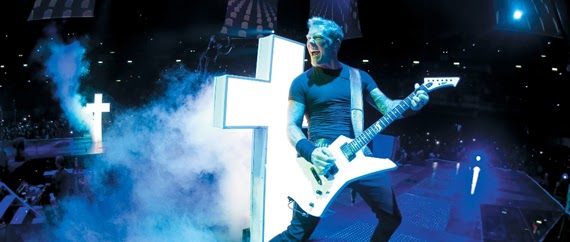When it came time for a director to be signed on, I presume they thought the script still needed work, because they got ahold of a pretty successful writer of this type of thing, Stuart Beattie, who has written the scripts for a couple of the Pirates of the Caribbean films, and for whom Frankenstein is his second directing job.
So while these are not the absolute best elements for quality picturemaking, I, Frankenstein turns out to be a rousing experience - if you go for this sort of thing. I will give it this: You CAN follow it.
1. It seems that the Frankenstein (Aaron Eckhart) monster is immortal. Why? No idea.
2. It seems that Satan's Demon Naberius (Bill Nighy) wants to know how the Frankenstein monster was created from dead people.
3. Naberius has made a good hire: The brilliant bio-scientist Terra (Yvonne Strahovski), to carry on Dr. Frankenstein's work.
4. God's Angels (known as Gargoyles because they hang out in this enormous cathedral) are more-or-less lead by Leonore (Miranda Otto), who is trying to keep the Frankenstein monster (who she calls Adam) and his secrets out of Naberius' hands.
5. After some initial reservations, Adam joins the side of the Gargoyles, after he finds out what Naberius plans on doing with the power to re-animate the dead.
6. The Mormons will love it!
As with last week's Jack Ryan: Shadow Recruit, this attempt to breath new life into an old (public domain) classic is a double-edged sword: the emphasis must be on "new," and while there is much in I, Frankenstein that we have seen before, the dramatic shape of this story had me going along with it. Maybe because I understood it - this helps.
But this method of coming up with a non-human enemy which you can show our Heroes slashing and hacking at without it being considered anything but "fantasy violence" IS beginning to get old. The Demons, when hit over the head hard enough, turn into big, noisy fireballs, and disappear, just like that! The Gargoyles, on the other hand, turn bright blue, and then vaporize and shoot up into the clouds (heavens?). Whatever.
We have seen the gorgeous, young, blond female scientist before too. There is a scene where, after Adam saves Doktor Terra from an army of attacking Demons, the two repair to the most over art-directed filthy hotel room, where she proceeds to do minor surgery on one of his shoulders. Adam is explaining to her for the first time the war between the Gargoyles and the Demons, and the entire big ugly picture. Her instruments going into Adam's shoulder sound just exactly like what they probably were made by: moving a knife around in a jar of strawberry preserves on the foley stage. She can't go on. The enormity of what Adam has told her is too much. All I kept thinking about was: Would this woman REALLY operate on Adam in a room THIS filthy? I don't think so.
Then too, there is Bill Nighy as the Big Bad Guy. His role in the film, and the function he has in this story is so formulaic that one wishes there was some other way to do it. And casting Bill Nighy isn't it. I like him as a performer, and I resect him for it, but as the bad guy in a film like this - I don't think so.
Eckhart does what he can also. But in turning the Frankenstein monster into a fairly good-looking fellow, the story has to focus on something else other than the monster's inability to play well with others. He loses much of what makes him special, and becomes a mere participant in a larger story. There is some interesting talk about the soul, and whether a re-animated body has a soul, and if not, why not and so on. All of this intrigued me to the point where I felt as the though the picture was doing what a movie like this ought to do and rarely does: build up steam toward a big finish in the third act.
When we get our first glimpses of Naberius' plans, we don't see the half of it. At the finale, the scale of his undertaking is revealed in all of its warped glory, and it is quite a sight. I do not like to give away endings to stories here, so I will say that the dramatic shape of this story expanded considerably and with it, my interest increased accordingly. I was really bowled over by the finish on this one. It's wild-assed fun.
Meanwhile, I, Frankenstein is being shown in 1:1.85 in IMAX® theatres, while in non-IMAX® theatres, it is being shown in 'Scope! We have not seen anything like this since the dawn of the widescreen age with the cropping of George Stevens' Shane! Since when has a more narrow screen been considered the premium format? Since when do the people in the less-expensive venues get the CinemaScope format?
 |
| Which feels like a bigger movie? 'Scope or. . . |
 |
| . . . 1:1.85? |





